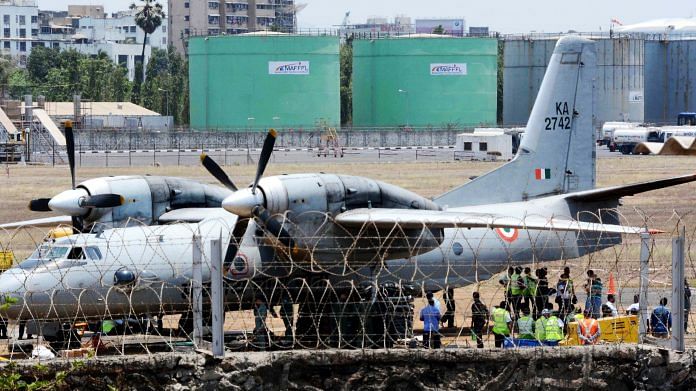New Delhi: The nearly four-decade-old AN-32 transport aircraft is known as the “workhorse” of the Indian Air Force, with airmen calling it a “very dependable aircraft” despite the loss of at least 18 aircraft to various crashes and accidents since the contract for it was signed in 1984.
The latest of these incidents took place in Arunachal Pradesh Monday when an AN-32 with 13 personnel on board went missing. A massive search operation is still on to find it, but has been unsuccessful so far.
Built for IAF demands
A look at the history of the aircraft, made by Soviet and later Ukrainian manufacturer Antonov, reveals that the AN-32 is nothing but a union of the airframe of the AN-26 transport aircraft and modified engines from the AN-12.
In the late 1970s, the IAF was looking for a medium transport aircraft that could be used to not just to drop loads in the eastern sector through the narrow valleys but also in the icy heights of the Himalayas — the Siachen, Leh and Ladakh regions.
The problem was that there was no aircraft that could match the IAF requirement. The USSR then offered a solution — the AN-32.
“It has the air frame of the AN-26 and the modified engines of the AN-12 which made it capable of dropping load of up to 4.5 tonnes in Siachen, and even making its way through the narrow valleys in the Northeast,” Air Marshal Dhiraj Kukreja (retd), former Air Officer Commanding-in-Chief of the Training Command told ThePrint.
The Air Marshal, who flew the AN-32 for most of his career, said: “It is a highly dependable aircraft and has taken both men and material to some of the toughest terrain.”
Also read: 10 years ago, another IAF AN-32 crashed in the same location with same number of people
Tech specs
The AN-32 got more powerful engines for better “hot and high” performance than its parent, the AN-26. However, it did retain the AN-26s unique short take-off and landing qualities thanks to high-mounted wings.
The engines are mounted on top of the wings, as opposed to under them, which allows a large-diameter propeller blade to be fitted, generating more thrust.
Power is from two ZMKB Progress AI-20DM turboprop engines, generating approximately 5,100 horsepower each.
From this base design, several variants have emerged, featuring increased Maximum Take-Off Weights (MTOWs), improved avionics and other systems, and altogether different engine installations.
A standard AN-32 crew has four members — two pilots, a flight engineer and loadmaster.
Performance specifications include a maximum speed of 330 miles per hour, a cruise speed of 292 miles per hour and a range out to 1,555 miles. Its listed service ceiling is 31,165 ft.
Also read: Jatropha plant fuel from Chhattisgarh to power Indian military aircraft
Almost exclusive to India
Interestingly, of the 250 AN-32s manufactured by Antanov, India bought 125.
This is an aircraft not even used by the USSR or Russia, but Air Marshal Kukreja pointed out that this was because “they did not need an aircraft to fly at such high altitude. They flew the AN-26 and over 1,500 of them were built”.
At least eight other countries operate the AN-32, but in very small numbers. Some have retired these aircraft from service.




Reform the toxic MoD Bureaucracy and everything else will fall into place.
look in chinese territory , plane will be found there
When the plane was designed and built has less to do with its accident. B-52 were built 70 years back. These have been upgraded and operational. My point is that who upgraded these cheaply. Were the parts used were genuine or local imitations.
Why were none of the occupants able to parachute out to safety before the 2009 and 2019 crashes? Dear author, please explain in a future article
Built in 80s does not make AN-32 old. It is future upgrades sometimes make it malfunction. Well Ukraine for upgrades is not the best place for upgrades.
If the basic configuration is sound, meets the IAF’s needs, perhaps HAL could, with the consent of Antonov, send it back to the drawing board and work on features that are proving problematic. B 52s are flying, 50 years after they were first inducted by the USAF.
Watched Cut the Clutter. Belong to a generation of Indians who have a lot of regard and affection for the Soviet Union. A relationship that needs to be nurtured.